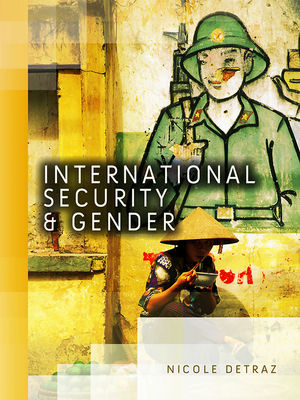 What does it mean to be secure? In the global news, we hear stories daily about the wars in Iraq and Afghanistan, about domestic–level conflicts around the world, about the challenges of cybersecurity and social security. This broad list highlights the fact that security is an idea with multiple meanings, but do we all experience security issues in the same way? In this book, Nicole Detraz explores the broad terrain of security studies through a gender lens. Natalie Novick finds that this accessible book provides a strong argument for further scholarship on gender throughout the security literature.
What does it mean to be secure? In the global news, we hear stories daily about the wars in Iraq and Afghanistan, about domestic–level conflicts around the world, about the challenges of cybersecurity and social security. This broad list highlights the fact that security is an idea with multiple meanings, but do we all experience security issues in the same way? In this book, Nicole Detraz explores the broad terrain of security studies through a gender lens. Natalie Novick finds that this accessible book provides a strong argument for further scholarship on gender throughout the security literature.
 International Security and Gender. Nicole Detraz. Polity. April 2013.
International Security and Gender. Nicole Detraz. Polity. April 2013.
Security studies have become ever more cluttered in academia since 9/11 and the “War on Terror”. Despite this blooming academic niche, a significant hole in the literature has remained: the investigation of the role of gender. Nicole Detraz‘s International Security & Gender is an important and timely text that answers a critical need in the literature. Gender is an aspect of international relations and security that is too often ignored, or if any attention is paid at all, relegated to minor attention. Through a vast review of the security literature, Detraz makes an excellent case for the greater understanding and incorporation of gender in security studies. Using “gender lenses”, Detraz puts feminist scholarship in context by illustrating how the role of gender in shaping inequalities has had a major impact across the field.
Detraz takes a view of security beyond state-centered definitions, basing it in a broader context that addresses human needs for protection, safety and freedom from danger. Across seven chapters, Detraz applies gender lenses to the debates within and among a wide range of conceptions of security, including human and environmental security, as well as traditional focuses on national security and militarization. Through a careful review of the literature, she shows how societal understandings of femininity and masculinity have helped to structure and shape gender relations within these areas. While on the surface they might not be visible, Detraz shows how of course gender relations exist everywhere, between states and their citizens, states and each other, among terrorists and their audiences, as well as within groups and individuals.
Each chapter breaks down some of these gendered discourses within a specific security context. Chapter 3 focuses on the role of gender in peacekeeping and peacebuilding. Gender issues structure how peacekeepers behave and operate, as well as their relationship with the host population, and the ultimate outcomes of their operations. Detraz raises that while the United Nations and other international actors have shown increasing attention to this issue in recent years, historically, “gender concerns have not always been a central element of peacebuilding”. This oversight has structured a history and experience of peacekeeping that is heavily male and military dominated. Pointedly, Detraz notes how a peacekeeping masculinity has structured relations with vulnerable populations in contrast to the peacekeeper’s role of the protector. This point attracts significant attention with the discussion of “peacekeeping economies” and the prevalence of both voluntary and forced prostitution in areas where peacekeepers are present.
In Chapter 4, “A Gendered Understanding of Terrorism”, Detraz shows how gender lenses can reveal new understandings about the multiple actors involved in terrorism, and how gendered discourse has structured how we understand and interpret terrorism. While women have long been a part of terrorist groups, “since 2000, there have been well over one hundred terrorist campaigns that have featured women”, reinforcing how we understand their role. Detraz recounts that when terrorists are female, they garner special attention by violating society’s expectations. For example, we know Basque terrorist fighter Idoia López Riaño more as “la Tigresa”, the Tigress, a “green-eyed femme fatale”, with “magnificent beauty” and “legendary sexual prowess” in addition to 23 assassinations. Male terrorists rarely garner this type of media coverage, suggesting that “women’s violence requires explanation in ways that men’s violence does not.” Detraz proposes that “male terrorists can be understood to be engaging in activities that do not fundamentally challenge gender norms in most societies”.
The points mentioned above are just two examples within two very packed chapters on peacekeeping and terrorism. Due to the text’s wide ranging and encompassing nature, unfortunately Detraz does not have enough time to go into much detail before she must move on to the next point. Some sections receive more attention than others, and some could benefit from more in-depth and empirical inquiry. It is this lack of depth that may limit the sway the text has against security scholars ardently opposed to gender inquiry. However, the goal of this volume is to serve as an introduction, and in this presentation it shows great applicability. Drawing on excellent literature from eminent names in the field, Detraz does a good job of breaking down arguments so that feminist theories and approaches are accessible and easily understood, regardless of background. Students who are new to international relations or security studies will not be intimidated, but at the same time the text does not aim too low. The concepts Detraz investigates in the text are not simple, one sided or without contest. However, she takes great care to thoughtfully present the discourse surrounding each concept, and to illustrate the varying debates over inclusion of gender in security issues. This well rounded and unbiased presentation gives readers the chance to formulate their own arguments on these multifaceted issues. The detailed introductions of each concept provide for a wide range of teaching applications. It would make a strong accompaniment to a course on international security or gender studies, or during a module on gender in an international relations or human rights course.
Many IR scholars remain to be convinced about the role of gender in international relations and security studies. However, this text makes clear that gendered discourse is in almost everything we read, see, and do, yet we often do not realize it. Using gender lenses makes this discourse apparent, and allows us to examine issues beyond what is typically visible in IR scholarship. This book makes these lenses known, and provides a strong argument for their further extension throughout the security literature.
——————————————————
Natalie Novick is currently pursuing a PhD in Sociology at the University of California, San Diego. Her research examines the outcomes of cultural and structural inequalities on women’s representation in government and foreign affairs. In 2009 she received her M.Sc. in Comparative European Politics from Trinity College, Dublin. Prior to her graduate studies she worked in legislative affairs in Washington, DC and Phoenix, Arizona. You can find her on twitter @genderpolitics. Read more reviews by Natalie.







